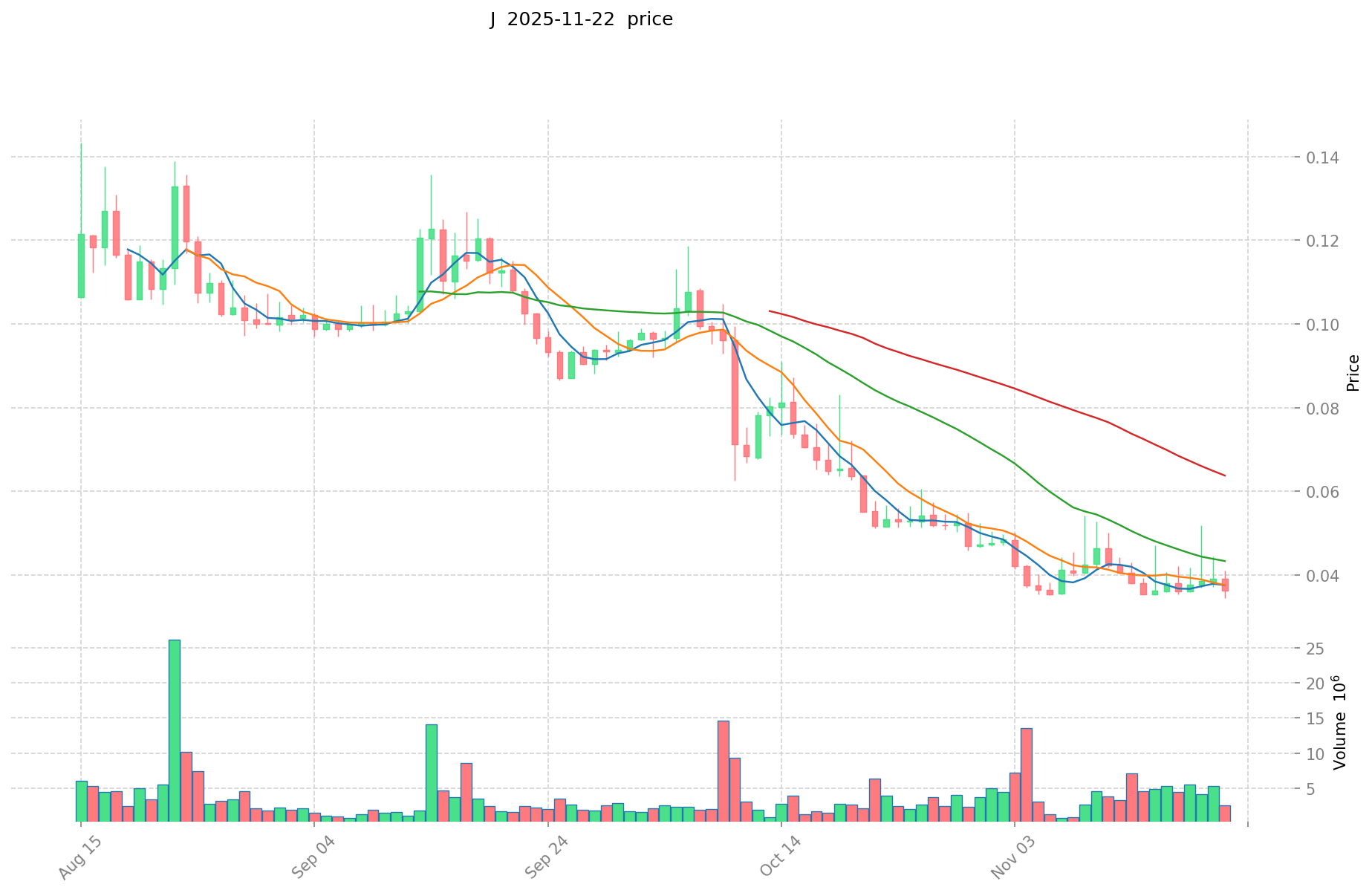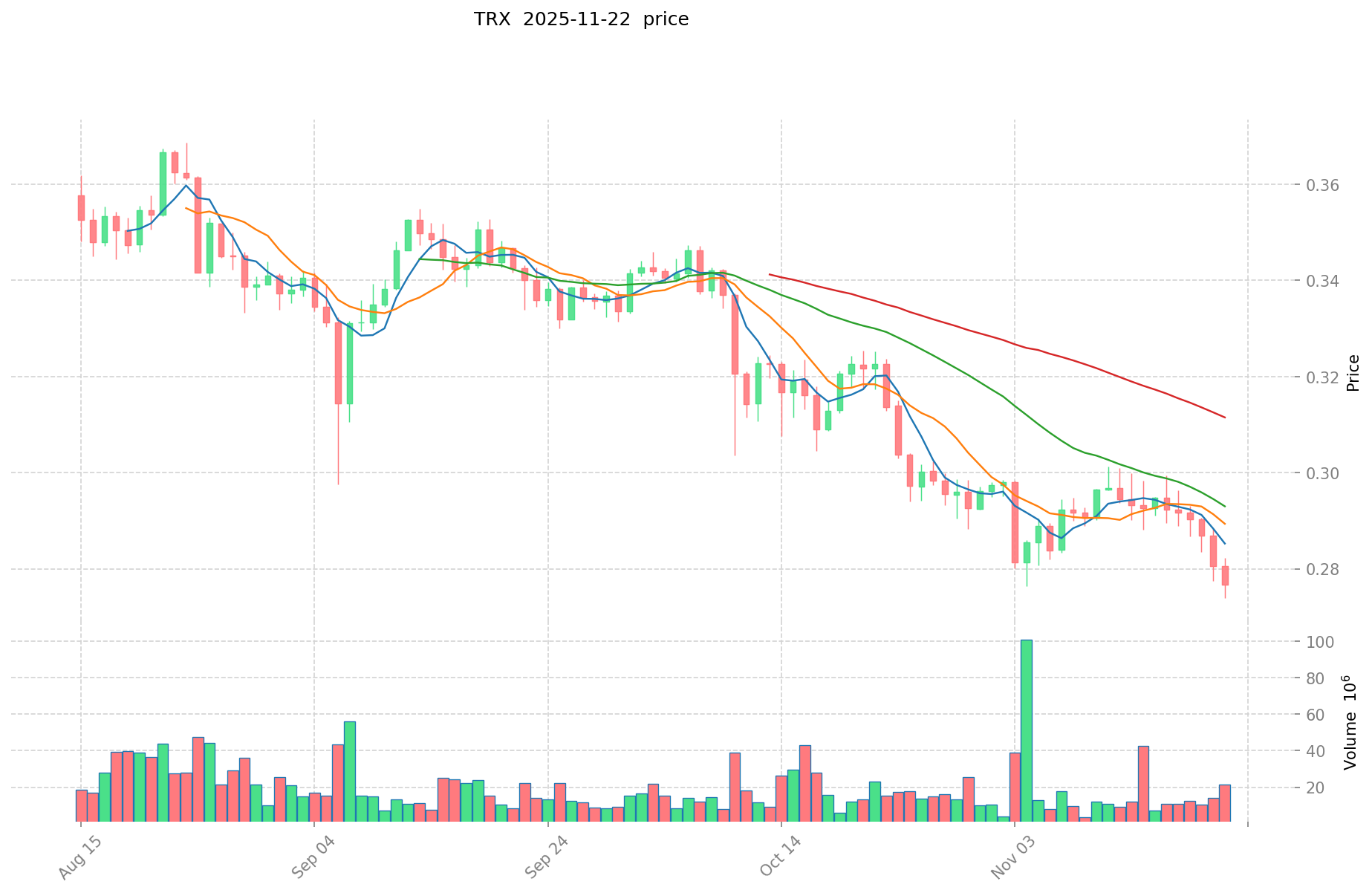J vs TRX: Battle of the Off-Road Titans - Which 4x4 Reigns Supreme?
Introduction: Investment Comparison between J and TRX
In the cryptocurrency market, the comparison between Jambo (J) vs TRON (TRX) has always been a topic that investors can't ignore. The two not only show significant differences in market cap ranking, application scenarios, and price performance, but also represent different positioning in crypto assets.
Jambo (J): Since its launch, it has gained market recognition for its commitment to building the world's largest mobile-first crypto network.
TRON (TRX): Since its inception in 2017, it has been hailed as a decentralized platform for content distribution, and has become one of the cryptocurrencies with the highest global transaction volume and market capitalization.
This article will comprehensively analyze the investment value comparison between J and TRX, focusing on historical price trends, supply mechanisms, institutional adoption, technological ecosystems, and future predictions, attempting to answer the question that investors are most concerned about:
"Which is the better buy right now?"
I. Price History Comparison and Current Market Status
J (Coin A) and TRX (Coin B) Historical Price Trends
- 2025: J experienced a significant price drop, reaching its all-time low of $0.03443 on November 21, 2025.
- 2024: TRX reached its all-time high of $0.431288 on December 4, 2024, marking a significant milestone for the project.
- Comparative analysis: In the recent market cycle, J has dropped from its all-time high of $1.5 to its current price of $0.03535, while TRX has shown more resilience, currently trading at $0.27339.
Current Market Situation (2025-11-23)
- J current price: $0.03535
- TRX current price: $0.27339
- 24-hour trading volume: J $49,890.27 vs TRX $2,952,245.95
- Market Sentiment Index (Fear & Greed Index): 11 (Extreme Fear)
Click to view real-time prices:
- Check J current price Market Price
- Check TRX current price Market Price


II. Core Factors Affecting Investment Value of JUP vs TRX
Supply Mechanism Comparison (Tokenomics)
- JUP: Jupiter has a fixed maximum supply of 10 billion tokens, with 90% of tokens held by the community.
- TRX: TRON uses an inflationary model with approximately 100 billion tokens in total. Annual inflation rate is around 2%.
- 📌 Historical Pattern: Fixed supply models like JUP's tend to create scarcity that can drive price appreciation during demand surges, while TRX's controlled inflation aims to support network growth while maintaining reasonable value.
Institutional Adoption and Market Applications
- Institutional Holdings: TRX appears to have greater institutional adoption with established partnerships with Samsung, Opera, and others. JUP is still emerging in terms of institutional interest.
- Enterprise Adoption: TRX has stronger use cases in payments and settlements through USDD stablecoin and BitTorrent integration. JUP is positioning itself for Web3 applications but has fewer established business applications.
- Regulatory Attitudes: TRX has faced regulatory scrutiny in some jurisdictions, while JUP's regulatory status is still developing as a newer project.
Technical Development and Ecosystem Building
- JUP Technical Upgrades: Jupiter focuses on Solana integration, providing composability and Web3 infrastructure. Their recent XLAs technology emphasizes scaling and privacy.
- TRX Technical Development: TRON has established a complete ecosystem with USDD stablecoin, BitTorrent integration, and a mature DApp platform.
- Ecosystem Comparison: TRX has a more developed ecosystem with over 200 million accounts and strong DeFi/stablecoin presence. JUP is building its ecosystem with emphasis on scalable infrastructure and developer tools on Solana.
Macroeconomic and Market Cycles
- Inflation Performance: TRX has demonstrated resilience during inflation periods due to its stable network growth and utility. JUP's performance against inflation is still unproven.
- Monetary Policy Impact: Both tokens are affected by broader crypto market trends tied to monetary policy, but TRX has shown more established trading patterns correlated with market cycles.
- Geopolitical Factors: TRX has significant adoption in Asia, particularly China, making it sensitive to regional regulatory developments. JUP's global distribution pattern is still emerging.
III. 2025-2030 Price Prediction: J vs TRX
Short-term Prediction (2025)
- J: Conservative $0.029382 - $0.0354 | Optimistic $0.0354 - $0.048498
- TRX: Conservative $0.191443 - $0.27349 | Optimistic $0.27349 - $0.4047652
Mid-term Prediction (2027)
- J may enter a growth phase, with an estimated price range of $0.03529379115 - $0.0598654179
- TRX may enter a bullish market, with an estimated price range of $0.34021280832 - $0.48325683
- Key drivers: Institutional capital inflow, ETF, ecosystem development
Long-term Prediction (2030)
- J: Base scenario $0.035975533726409 - $0.065410061320743 | Optimistic scenario $0.065410061320743 - $0.092228186462248
- TRX: Base scenario $0.341366584001625 - $0.5251793600025 | Optimistic scenario $0.5251793600025 - $0.772013659203675
Disclaimer: This analysis is based on historical data and market projections. Cryptocurrency markets are highly volatile and unpredictable. This information should not be considered as financial advice. Always conduct your own research before making investment decisions.
J:
| 年份 | 预测最高价 | 预测平均价格 | 预测最低价 | 涨跌幅 |
|---|---|---|---|---|
| 2025 | 0.048498 | 0.0354 | 0.029382 | 0 |
| 2026 | 0.04740237 | 0.041949 | 0.03104226 | 18 |
| 2027 | 0.0598654179 | 0.044675685 | 0.03529379115 | 26 |
| 2028 | 0.0705652444575 | 0.05227055145 | 0.034498563957 | 47 |
| 2029 | 0.069402224687737 | 0.06141789795375 | 0.047905960403925 | 73 |
| 2030 | 0.092228186462248 | 0.065410061320743 | 0.035975533726409 | 85 |
TRX:
| 年份 | 预测最高价 | 预测平均价格 | 预测最低价 | 涨跌幅 |
|---|---|---|---|---|
| 2025 | 0.4047652 | 0.27349 | 0.191443 | 0 |
| 2026 | 0.434083328 | 0.3391276 | 0.267910804 | 24 |
| 2027 | 0.48325683 | 0.386605464 | 0.34021280832 | 41 |
| 2028 | 0.4784242617 | 0.434931147 | 0.25660937673 | 59 |
| 2029 | 0.593681015655 | 0.45667770435 | 0.2420391833055 | 67 |
| 2030 | 0.772013659203675 | 0.5251793600025 | 0.341366584001625 | 92 |
IV. Investment Strategy Comparison: J vs TRX
Long-term vs Short-term Investment Strategies
- J: Suitable for investors focused on Web3 infrastructure potential and Solana ecosystem growth
- TRX: Suitable for investors seeking established networks with strong DeFi and stablecoin presence
Risk Management and Asset Allocation
- Conservative investors: J: 10% vs TRX: 90%
- Aggressive investors: J: 30% vs TRX: 70%
- Hedging tools: Stablecoin allocation, options, cross-currency portfolio
V. Potential Risk Comparison
Market Risks
- J: High volatility due to newer project status and smaller market cap
- TRX: Exposure to broader crypto market trends and Asian market regulations
Technical Risks
- J: Scalability, network stability on Solana
- TRX: Hash power concentration, security vulnerabilities
Regulatory Risks
- Global regulatory policies may have differing impacts on both, with TRX potentially facing more scrutiny due to its larger market presence
VI. Conclusion: Which Is the Better Buy?
📌 Investment Value Summary:
- J advantages: Potential for growth in Web3 infrastructure, Solana ecosystem integration
- TRX advantages: Established ecosystem, strong DeFi presence, proven resilience in market cycles
✅ Investment Advice:
- Novice investors: Consider a higher allocation to TRX for its established market position
- Experienced investors: Balanced approach with both J and TRX, adjusting based on risk tolerance
- Institutional investors: Evaluate J for long-term potential, maintain TRX for current ecosystem strength
⚠️ Risk Warning: Cryptocurrency markets are highly volatile. This article does not constitute investment advice. None
VII. FAQ
Q1: What are the main differences between J and TRX in terms of market position? A: J is a newer project focused on building a mobile-first crypto network, while TRX is an established platform for content distribution with a high global transaction volume and market capitalization.
Q2: How do the supply mechanisms of J and TRX differ? A: J has a fixed maximum supply of 10 billion tokens, with 90% held by the community. TRX uses an inflationary model with approximately 100 billion tokens and an annual inflation rate of around 2%.
Q3: Which cryptocurrency has shown better price performance recently? A: TRX has shown more resilience in the recent market cycle, currently trading at $0.27339, while J has dropped from its all-time high of $1.5 to its current price of $0.03535.
Q4: What are the key factors affecting the investment value of J and TRX? A: Key factors include supply mechanisms, institutional adoption, market applications, technical development, ecosystem building, and macroeconomic conditions.
Q5: How do J and TRX compare in terms of institutional adoption? A: TRX appears to have greater institutional adoption with established partnerships, while J is still emerging in terms of institutional interest.
Q6: What are the long-term price predictions for J and TRX by 2030? A: For J, the base scenario predicts $0.035975533726409 - $0.065410061320743, while for TRX, the base scenario predicts $0.341366584001625 - $0.5251793600025.
Q7: How should investors approach risk management when investing in J and TRX? A: Conservative investors might consider allocating 10% to J and 90% to TRX, while aggressive investors might opt for 30% J and 70% TRX. Hedging tools like stablecoin allocation, options, and cross-currency portfolios are recommended.
Q8: What are the potential risks associated with investing in J and TRX? A: Risks include market volatility, technical challenges such as scalability and security, and regulatory uncertainties. J may face higher volatility due to its newer status, while TRX may be more exposed to Asian market regulations.
Share
Content